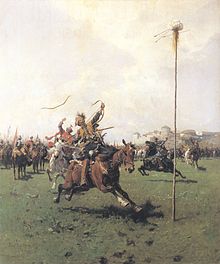Lisowczyks
Lisowczyks or Lisowczycy (Polish pronunciation: [lisɔfˈt͡ʂɨt͡sɨ]; also known as Straceńcy ('lost men' or 'forlorn hope') or chorągiew elearska (company of elears); or in singular form: Lisowczyk or elear) was the name of an early 17th-century irregular unit of the Polish–Lithuanian light cavalry. The Lisowczycy took part in many battles across Europe and the historical accounts of the period characterized them as extremely agile, warlike, and bloodthirsty. Their numbers varied with time, from a few hundred to several thousand.

The origin of the group can be traced to
The Lisowczycy took part in many conflicts, including the
An account of Lisowczycy's exploits was written by their

Prologue: the konfederacja
In 1604, during the early stages of the
Trial of Blood: the Dymitriad
Eventually, after the rebel forces were defeated at the
In 1608, together with
Lisowski's soldiers in Northern Russia (1612–13)
In 1612, when the Polish occupation of the
After Russian recapture of Moscow, most of the Polish brigands headed to the area of
On July 10, 1612, Poles captured Belozersk without fight. The town was looted, and its governor fled to Kirillov, hiding in the fortified Kirillo-Belozersky Monastery. Lisowski's men reached the monastery on August 20, but its siege did not begin until December 1612. Since Polish brigands, numbered at some 3000 men, did not have any artillery, they failed to capture the abbey with its stone walls.
On December 12–15, 1612, a unit of Bobowski three times tried to capture the town of
In search of food and booty, Lisowski's soldiers moved further northwards, reaching as far as
The brigands, numbering some 1200 and commanded by Stanislaw Jasinski, appeared at Kholmogory on December 6, 1613. Again, they failed to capture the town, and decided to head to Arkhangelsk, which they unsuccessfully besieged between December 14–19, 1613. Jasinski and his soldiers then marched towards the Northern Dvina estuary and the White Sea shore. There, they captured Severodvinsk and burned Nikolo-Korelsky Monastery, after which they ransacked local villages, reaching as far as Karelia.
Death of Lisowski, birth of the Lisowczycy

The name of Lisowczycy was carried by the troops ever since Lisowski's passing. Despite his death, they remained a most significant threat: in 1616 they captured
Devils in the Holy Empire

From 1619, the Lisowczycy, then stationed near
Then Lisowczycy split: part of them, with Rogowski, decided to return to Poland, pillaging Slovakia on their way. Others, under Jarosz Kleczkowski, remained in the service of the Emperor for the next few years. After the death of Kleczkowski (March 4, 1620) at the Battle of Krems, Stanisław Rusinowski became the new commander of the Lisowczycy. Under Rusinowski, the Lisowczycy took part in the Battle of White Mountain (November 8) where they captured twenty standards. On May 7, 1621, the Emperor paid them their outstanding wages and released them from service, due to numerous complaints about their behaviour. Some of them returned to Poland, others served under Maximilian I, Elector of Bavaria.
Cecora and Chocim (Khotyn)
The Lisowczycy fought in the wars between Commonwealth and the
Epilogue
After the conflict with the Ottomans was settled, many Lisowczycy, then under the command of
However, the Lisowczycy proved to be a pestilence wherever they went, and soon most of its members formed
The last time that companies using the Lisowczycy name took part in a major war was during the late 1620s, when they were temporarily reformed to fight in Poland's continuing conflict against the Swedes in Polish
Even after the formation was disbanded, its members were respected (or at least, feared) even beyond the Commonwealth. Soon, their atrocities were forgotten and their exploits as the defenders of the Commonwealth and faith against the
Sources
- (in Polish) Lisowczycy nad oceanem Lodowatym.Opowieść o św. Hiobie Mazowskim, by Zbigniew Wierzbicki. 22.12.2012
Further reading
- Władysław Magnuszewski, Z dziejów elearów polskich. Stanisław Stroynowski, lisowski zagończyk, przywódca i legislator, PWN, Warszawa – Poznań 1978.
- Kazimierz Korkozowicz, Jeźdźcy Apokalipsy t. 1–3., Wyd. MON, Warszawa 1990.
- Bohdan Królikowski, Szable nie rdzewiały, Wyd. MON, Warszawa 1983.
- Aleksander Lisowski, [w:] Szymon Starowolski, Wojownicy sarmaccy, Wyd. MON (wyd. I), Warszawa 1978, s. 270–273.
- Ferdynand Antoni Ossendowski, Lisowczycy. Powieść historyczna, Wydawnictwo Polskie R. Wegnera, Poznań 1929; Wyd. Libra (wyd. I powojenne), Warszawa 1990.
- Bogusław Sujkowski, Lisowczycy. Powieść historyczna z XVII w., Wyd. Łódzkie (wyd. III), Łódź 1988.
- Henryk Wisner, Lisowczycy, Dom Wyd. Bellona (wyd. II, poprawione i uzupełnione), Warszawa 2004, ISBN 83-11-09927-8.
- Tadeusz Nowak, Jan Wimmer, Dzieje oręża polskiego do roku 1793, Warszawa 1968.
- Radosław Sikora, Wojskowość polska w dobie wojny polsko-szwedzkiej 1626–1629. Kryzys mocarstwa, Poznań 2005.
